When we introduced the concept of Q5 last September, we highlighted its potential as a hidden opportunity in the TV advertising calendar. Seven diverse brands took the leap during Q5 2024/2025, and their Google search trends tell an illuminating story – not just about the power of TV advertising, but about the journey brands take towards mass media success.
A Note on Search Data Analysis
While our Q5 analysis focuses on absolute search volumes to observe TV’s potential impact, it’s worth noting that search data can be analyzed through various lenses for different strategic insights.
Notable thought leaders Les Binet and James Hankins have developed the concept of Share of Search (SoS) as a valuable metric for understanding competitive market position. Share of Search examines a brand’s search volume relative to its competitive set, providing insights into:
– Category growth or decline
– Competitive share shifts
– Emerging market threats and opportunities
For our Q5 TV impact analysis, we deliberately focused on individual brand patterns rather than competitive share, as we wanted to understand how different categories respond to TV exposure* during this unique period. However, combining both absolute search analysis and Share of Search metrics could provide even richer insights for long-term brand building strategies.
Also, the financial figures referenced in this analysis represent gross media investments on Linear TV only.
This simplified approach allows us to make general observations about campaign scale, but readers should be aware that actual media investments may differ from the gross figures presented. A comprehensive ROI analysis would require more detailed financial data than is available for this research.
Now back to the research observations.
The results revealed a crucial insight: TV can be a powerful lever for growth, but like any sophisticated marketing tool, its effectiveness often depends on seasonality, timing and market readiness. Some brands saw immediate uplift in their search volumes, demonstrating TV’s ability to drive curiosity and discovery. With others, we learned valuable lessons about market education and messaging that will help shape their future TV strategies.
Think of Q5 TV advertising as exploring new waters – new ponds, new fish, and most importantly, new opportunities for growth. But just as in fishing, success isn’t just about where you fish, but also about when you cast your line and what bait you use. Let’s explore what these seven diverse cases revealed about consumer behavior during Q5.
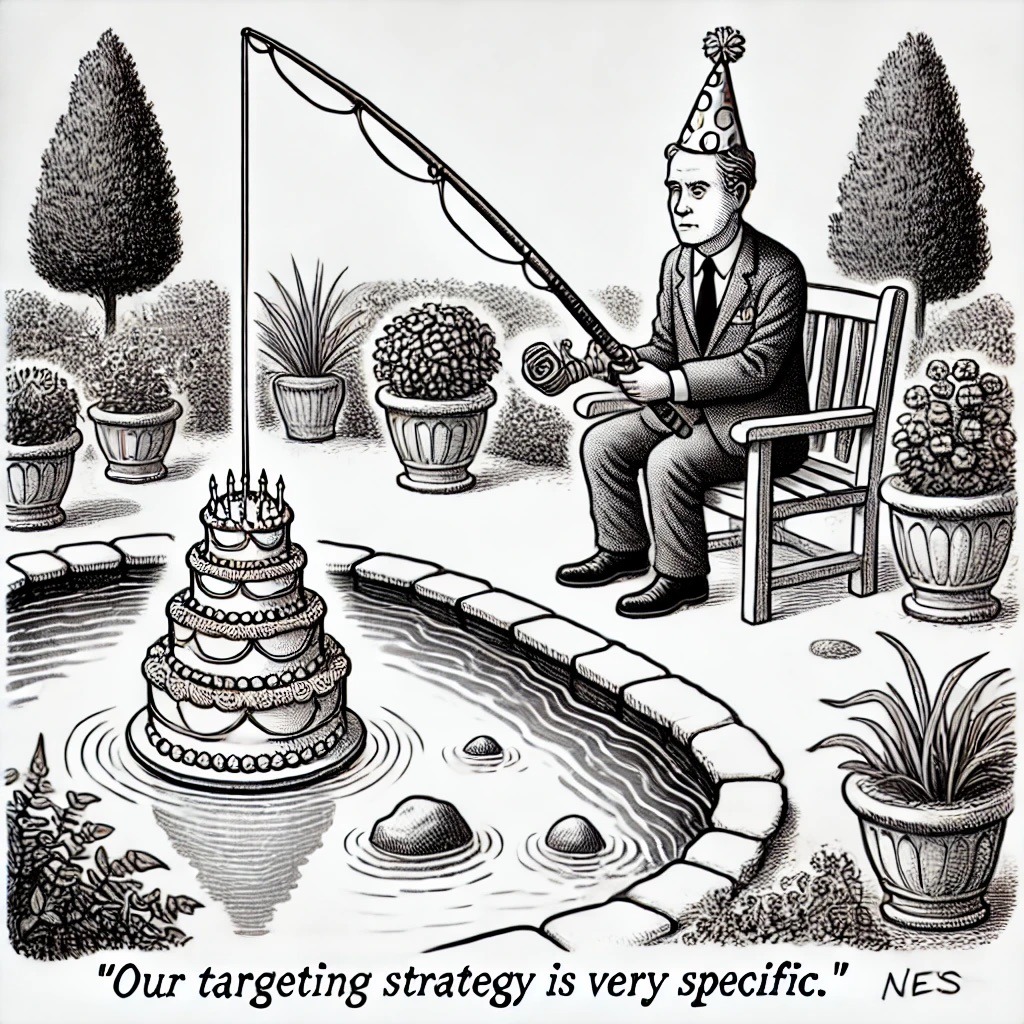
Search Trend Analysis by Industry
The following visualizations demonstrate how different industries responded to TV advertising during Q5. Based on our analysis, we observed three distinct categories of response:
- Immediate Response Industries: These established categories showed quick and substantial search uplift following TV exposure.
- Gradual Response Industries: Categories which demonstrated steady growth in search interest over time, often aligned with seasonal factors.
- Early Stage Categories: New or complex offerings requiring longer market/consumer education periods.
Let’s take a closer look at each category.
Immediate Response Industries:
Food Delivery:
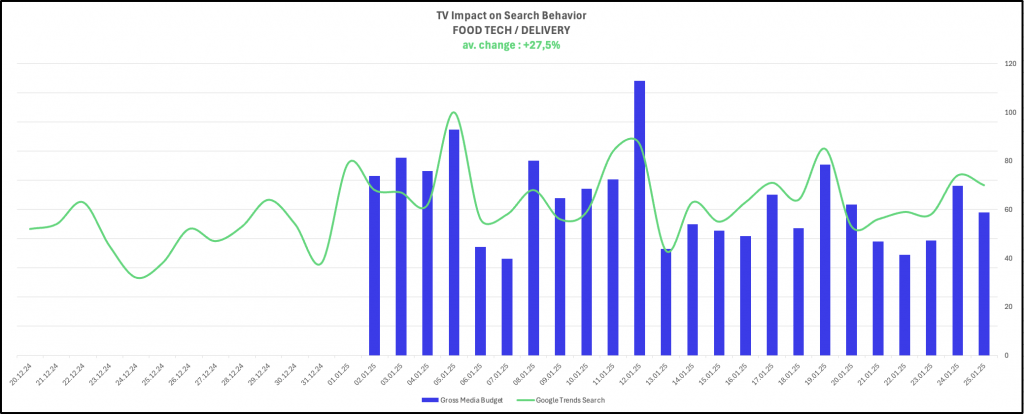
- Showed consistent uplift in search activity following campaign launch
- Weekend patterns visible in search behavior
- Clear elevation in baseline search volume during campaign period
Gaming & Entertainment (gross media spends unavailable):
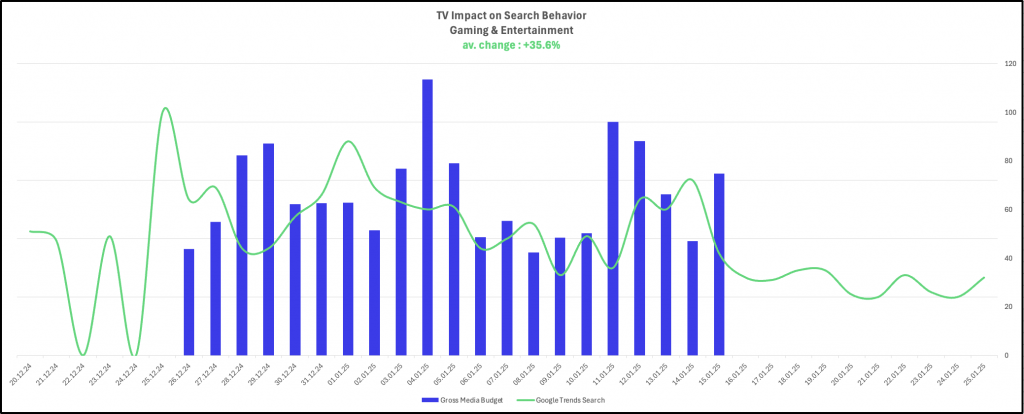
- Shorter campaign window (Dec 26 – Jan 15) capturing holiday gaming period
- Immediate response in search behavior trend alignment starting Jan. 5th
- Search patterns showed variations during the campaign period
Gradual Response Industries:
Health & Wellness Brand:
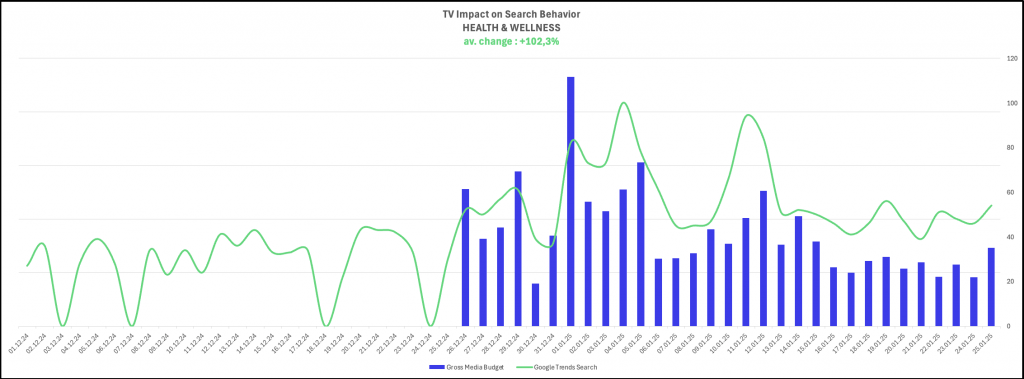
- Timing aligned with New Year’s resolution period
- Gradual build in search interest
- Sustained elevation in search patterns
Natural Food Products:
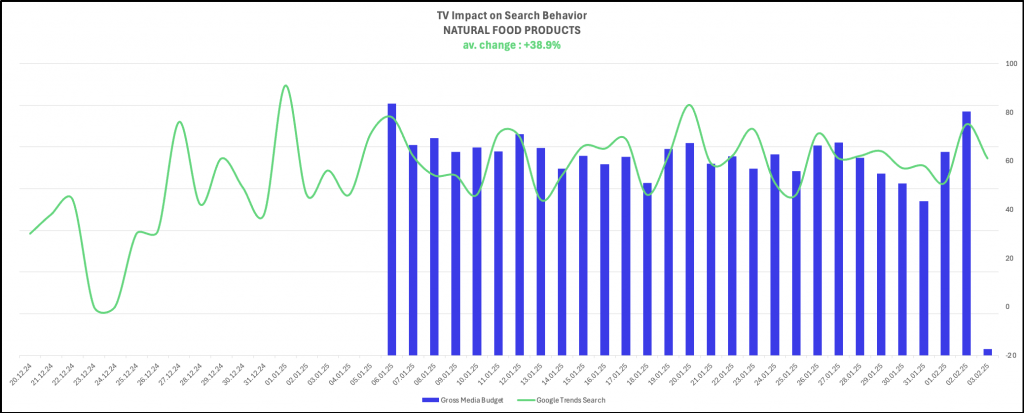
- Similar pattern to general health category
- Initial spike followed by sustained interest
- Seasonal alignment with health-conscious period
Luxury Accessories:
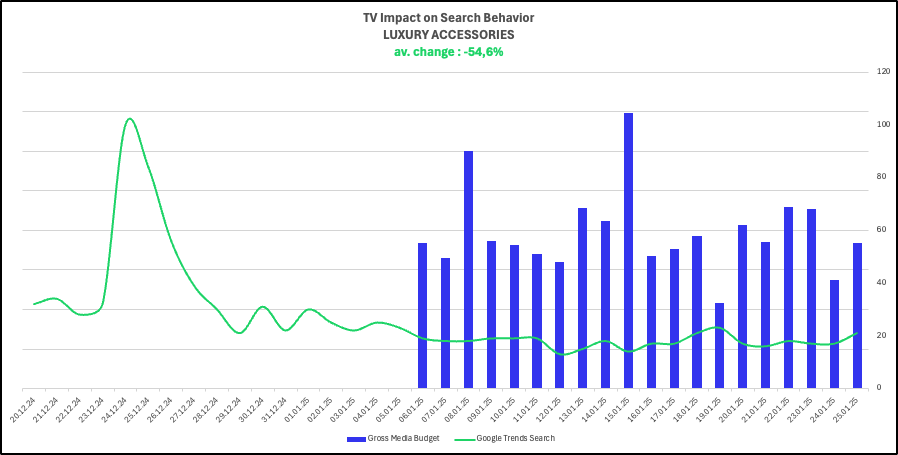
- Search volume unresponsive despite TV advertising after Christmas peak
- Post-holiday “gifting fatigue” affects luxury category
- Q5 timing may not align with luxury accessories purchase cycle
Early Stage Categories:
These categories introduced newer concepts or addressed specific needs, showing interesting patterns in search behavior.
Payment Solutions:
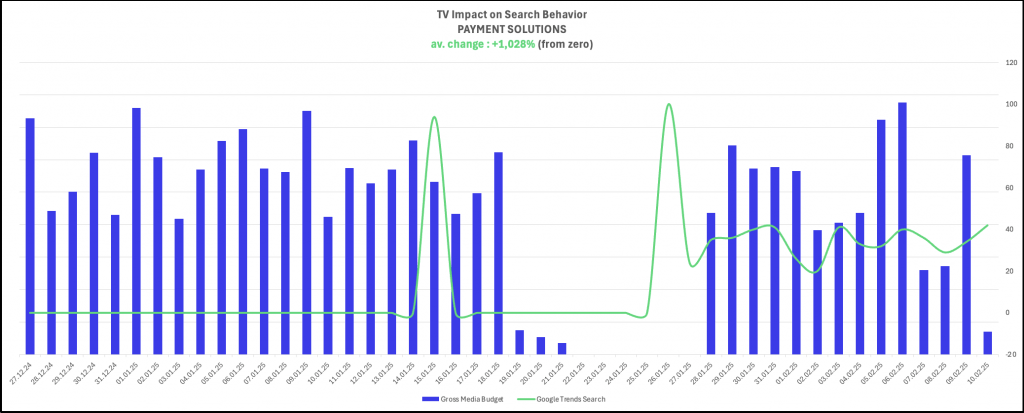
- More modest change in search behavior
- Complex product category may require longer education period
- Search patterns suggest early-stage market development
Women's Health & Wellness:
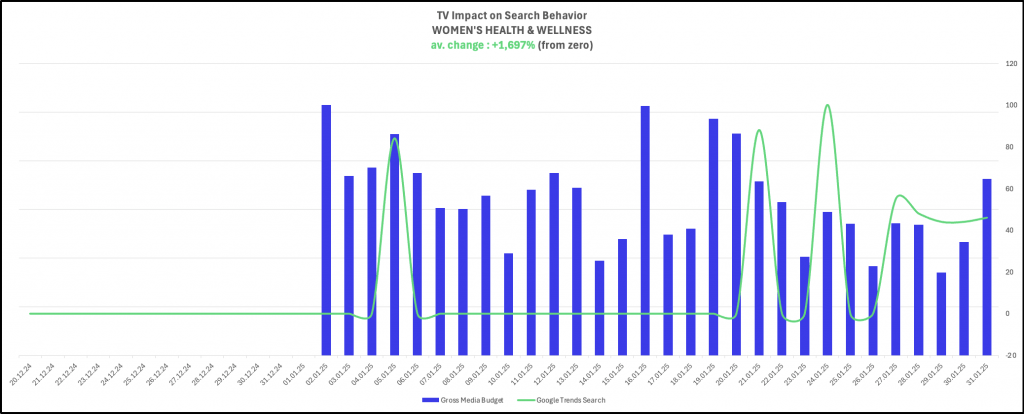
- Niche category showing gradual response
- Early stages of category development reflected in search patterns
- New Year’s timing aligns with health-focused consumer mindset
- The data shows a pattern of building momentum, with the strongest performance in the final week of the campaign. Signalling a potential build in category awareness.
Personal Finance App:
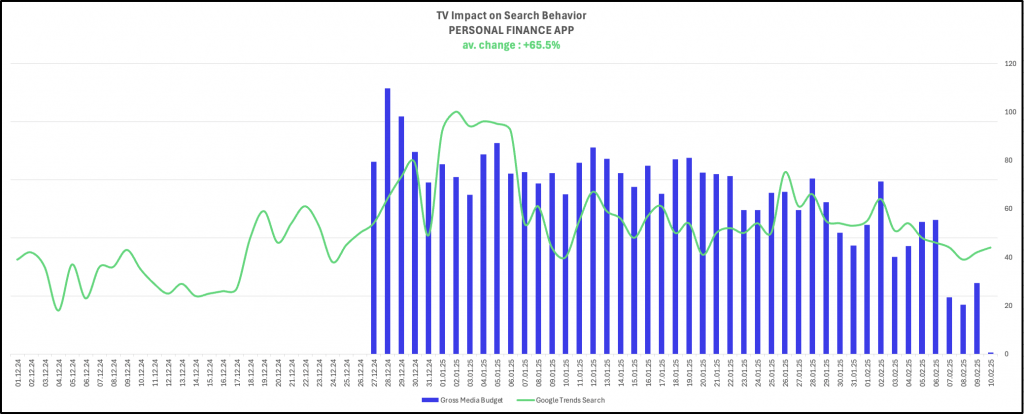
- New Year timing captures “financial resolution” mindset
- Search patterns suggest consumer education journey
- Financial services category showing mixed immediate response
PRO TIP: For early stage categories, establishing baseline awareness through TV should be supported by a robust digital strategy. While TV can introduce new concepts to a broad audience, SEO and SEA play crucial roles in providing deeper category education. Supporting content that addresses specific topics and common questions can help accelerate market understanding and engagement.
Understanding the Limits of Search Data
While these industry visualisations reveal clear patterns in consumer search behavior, it’s important to acknowledge what search data alone can and cannot tell us about TV’s impact.
Search behavior is a valuable indicator, but it’s just one part of a broader measurement framework. Post-purchase surveys have revealed that TV’s influence often extends beyond immediate search activity, playing a crucial role in building brand familiarity and trust.
Looking Forward: Implications for Future Q5 Planning
For brands considering Q5 2025/2026, these cases suggest several key considerations:
- Category Readiness Matters
- Assess your category’s maturity and consumer familiarity
- Consider seasonal timing and consumer mindset
- Understand the education level your product requires
- Set Appropriate Expectations
- Immediate Response Industries: Expect quick uplift
- Gradual Response Industries: Plan for steady growth
- Early Stage Categories: Focus on establishing baseline awareness
- Think Beyond Immediate Response
- Use Q5’s cost efficiency for testing and learning
- Consider TV’s role in building long-term brand familiarity
- Align campaign duration with category needs
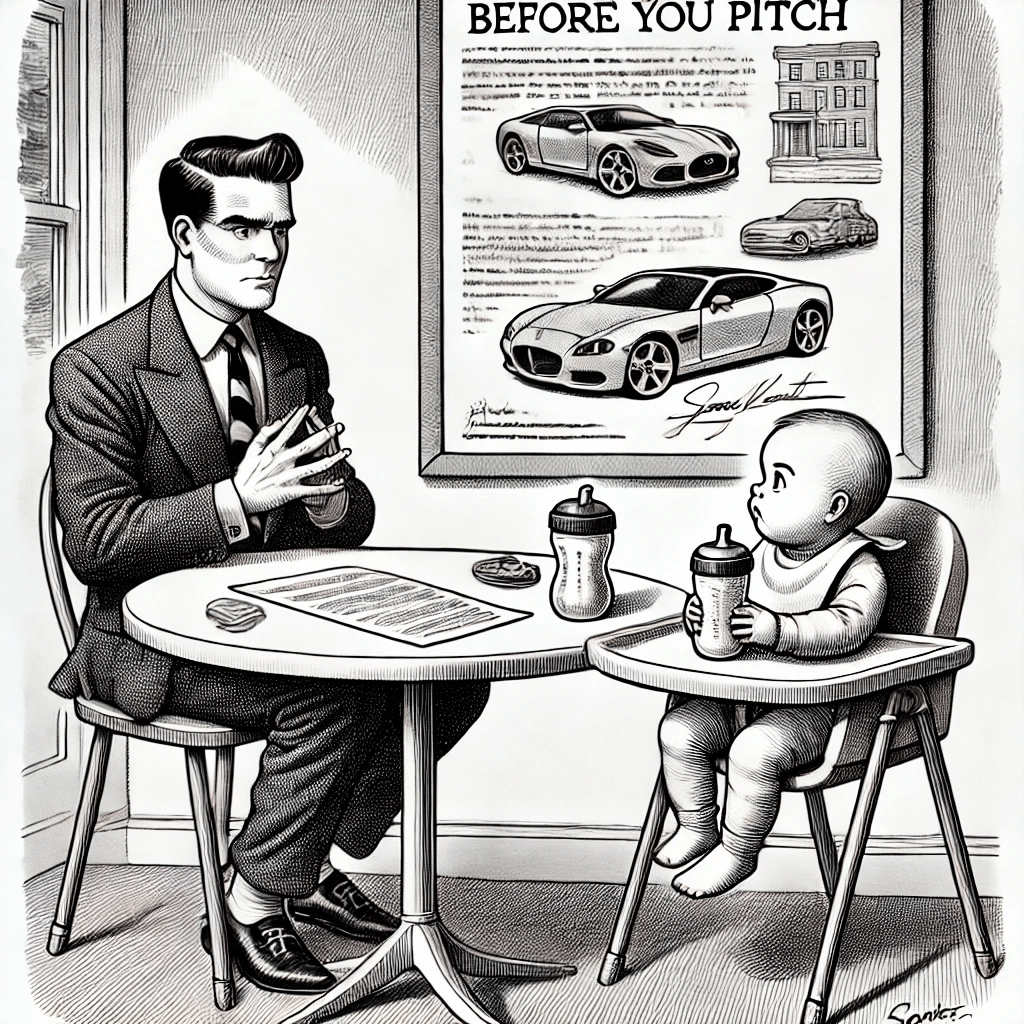
🤔While this analysis provides a focused look at individual brand responses to Q5 TV campaigns, additional layers of analysis could further refine strategic takeaways.
Future iterations could explore Share of Search trends to provide a competitive lens on market shifts, alongside indexed uplift metrics that quantify TV’s role in the full consumer journey.
And since we all have a tendency to be data-driven-happy, a deeper look at how brands integrated digital channels with TV campaigns would enrich the understanding of omnichannel impact.
As with any search-driven analysis, inherent biases—such as pre-existing brand familiarity—should be considered when interpreting the data.
Nevertheless, it was an interesting research project 🥸
Conclusion: The Q5 Opportunity Remains Strong
What we’ve learned from these diverse brands reinforces our initial hypothesis about Q5’s unique opportunity while adding important nuance to our understanding. The combination of high viewership and favorable media costs continues to make Q5 an attractive entry point for TV advertising, but success requires careful consideration of your brand’s market position, communication approach and readiness.
💡Future thought:
Looking ahead, an intriguing question emerges from this research: Could “Cost per Search” serve as a meaningful metric to indicate consumer intention? As we continue to analyze TV’s impact on digital behavior, this metric might offer new insights into how different categories build their presence in consumers’ minds. Stay tuned as we explore this concept in our future analyses.












